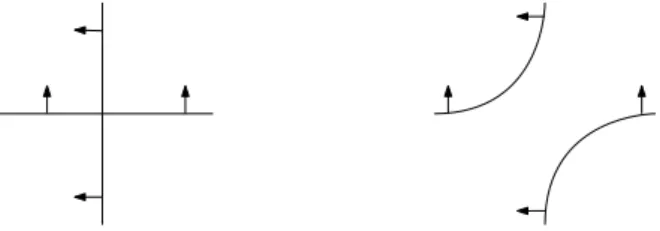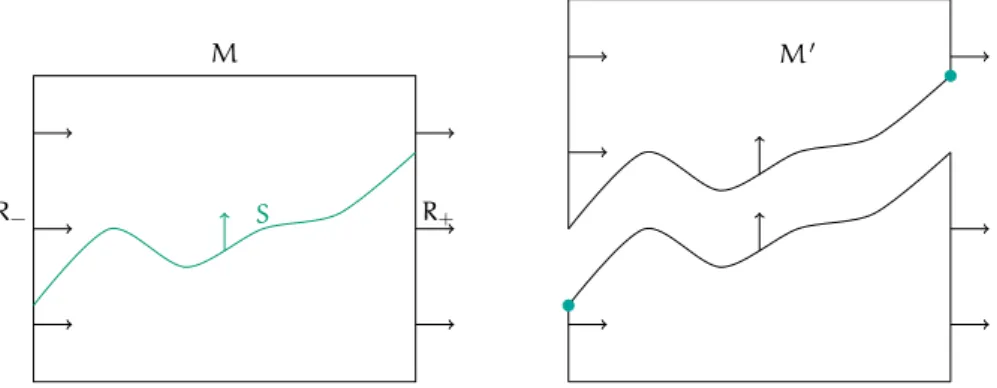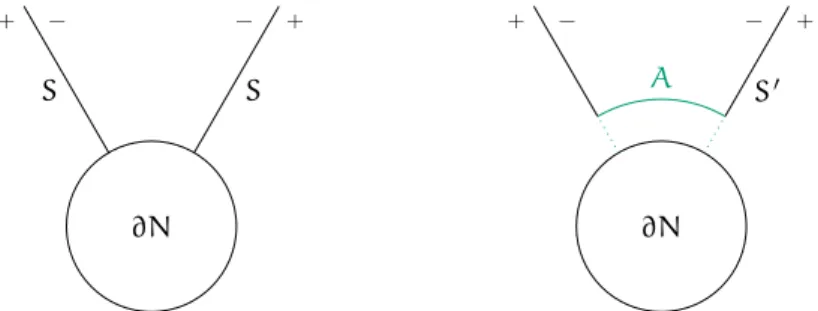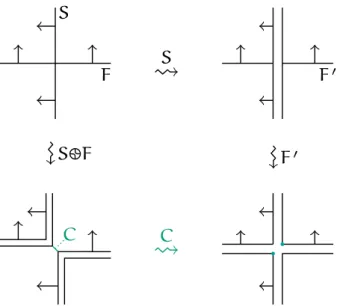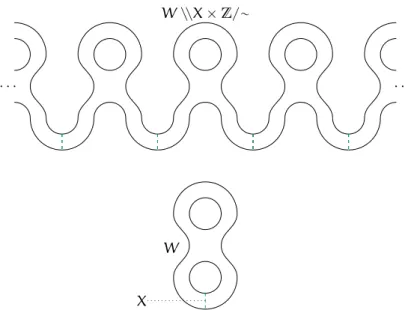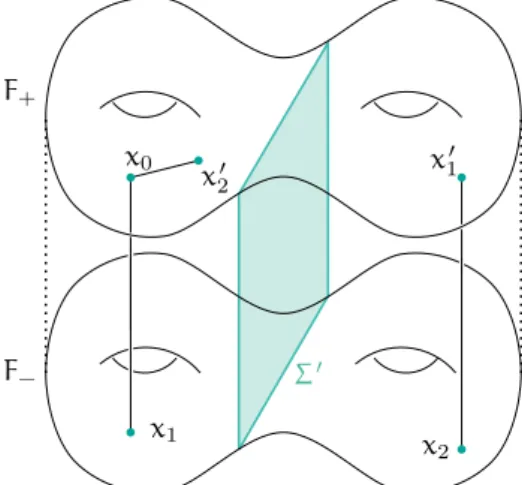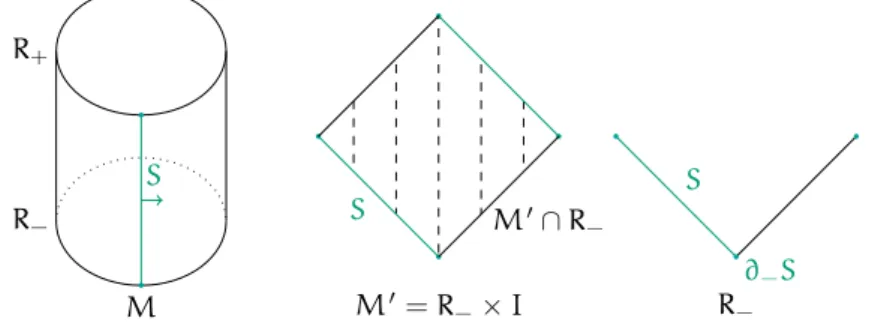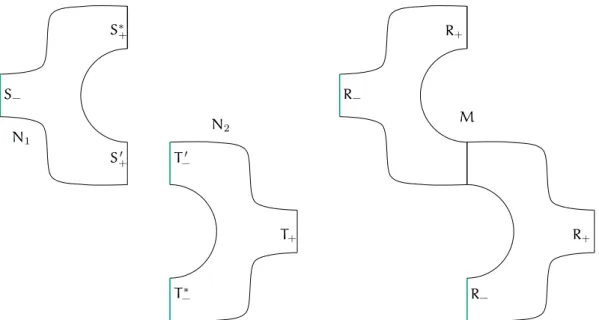upper bound on the leading coefficient
Dissertation zur Erlangung desDoktorgrades derNaturwissenschaften (Dr. rer. nat.) derFakultat f¨ ur¨ Mathematik derUniversitat¨ Regensburg
vorgelegt von Gerrit Herrmann aus
K ¨oln im Jahr 2019
Die Arbeit wurde angeleitet von Prof. Stefan Friedl.
Contents
I. Prelude iii
Introduction iv
1. Motivation . . . . iv
2. Organisation of the thesis . . . . vi
3. Acknowledgements . . . . vii
A brief history of 3-manifold topology viii II. Main Part 1 1. Surfaces in 3-manifolds 2 1.1. Thurston norm . . . . 2
1.2. Sutured manifolds . . . . 9
1.3. Cut along a hypersurface and cyclic covers . . . . 15
1.4. Virtual fibring and quasi-fibres . . . . 20
2. L2-invariants 24 2.1. N(G)-modules and the von Neumann dimension . . . . 24
2.2. L2-Betti numbers . . . . 27
2.3. L2-torsion . . . . 30
3. Vanishing of relative L2-Betti numbers for taut sutured manifolds 36 3.1. Main theorem and applications . . . . 36
3.2. Supplementary results . . . . 38
3.3. Proof of the main theorem . . . . 41
4. Relative torsion 46 4.1. Basic properties and gluing formulas . . . . 46
4.2. On the combinatorics of Thurston norm minimizing surfaces repre- senting the same class . . . . 50
5. An upper bound on the leading coefficient 56 5.1. L2-Alexander torsion . . . . 56
5.2. The work of Liu and the definition of the leading coefficient . . . . 58
5.3. Upper bound for the leading coefficient . . . . 60
6. Some calculations 72 6.1. Ahyperbolic surfaces . . . . 72
III. Appendix 79
A. Semi-norms on free abelian groups 80
A.1. Hahn-Banach and simple applications . . . . 80 A.2. Integral semi-norm on a free abelian group . . . . 82
B. Twisted coefficients and Poincar´e duality 87
B.1. Definition and basic properties . . . . 87 B.2. Poincar´e duality . . . . 90
Prelude
Introduction
1. Motivation
A knot K in S3 is a smooth embedding K: S1 → S3. It is a classical result due to Seifert [Sei35] that for every knot K there exists an embedding i: F → S3 of a connected compact oriented surfaceFsuch thati|∂F =K. Such an embedded surface is called a Seifert surface for K. Once the existence of such a surface is established, there are three natural and interesting questions to consider:
Question 0.1. When does a Seifert surface for K have minimal genus compared to all other Seifert surfaces forK?
Question 0.2. How are two minimal genus Seifert surfaces for the same knot related?
Question 0.3. Can we use minimal genus Seifert surfaces to distinguish knots?
A very simple example is the unknot. The unknot bounds a disc which has genus zero. Since there is no lower genus, the disc is a minimal genus Seifert surface for the unknot. It is also a classical fact that all smooth embeddings of D2 into S3 are isotopic. There is only one isotopy class of a minimal genus Seifert surface for the unknot. Since the unknot is the only knot to bound a disc, we see that the minimal Seifert surface helps us to distinguish the unknot from other knots. Finding answers to the above questions becomes much more challenging if one considers more difficult knots.
Before we look at the questions more closely, we describe a generalisation of the concept of minimal genus Seifert surface to arbitrary 3-manifolds due to Thurston.
He considered for a surface S the complexity defined by χ−(S) := −χ(S\ discs andspheres ).
Given a 3-manifold N and a homology class σ ∈ H2(N,∂N;Z), Thurston [Th86]
studied the value
kσk:=min{χ−(S)|S⊂Nproperly embedded surface and[S] = [σ]}. Nowadays one refers to the value as the Thurston norm ofσ.
The three questions above can be generalised as follows.
Question 0.4. When is a given surfaceSinNThurston norm minimizing?
Question 0.5. How are two Thurston norm minimizing surfaces for the same ho- mology class related?
Question 0.6. Can we use Thurston norm minimizing surfaces to distinguish 3- manifolds?
The author contributes to all three questions some results in this thesis.
Characterisation of Thurston norm minimizing surfaces
For technical reasons we restrict Question 0.4 to the following subclass of surfaces.
A decomposition surfaceSin a 3-manifoldNis a surface without discs and spheres and for any choice of base pointx∈Sthe inclusionS→Ninduces a monomorphism π1(S,x)→π1(N,x).
Friedl–T. Kim showed a characterisation of Thurston norm minimizing surfaces in terms of twisted homology groups:
Theorem 0.7([FK13, Theorem 1.1] ). LetSbe a non-separating non-empty decomposition surface in a connected compact oriented 3-manifoldNwith empty or toroidal boundary. We abbreviateM=N\S×(−1, 1)andS− =S×{−1}.The surfaceShas minimal complexity in its homology class if and only if there exists a unitary representationα: π1(M) →U(k) such thatH∗(M,S−;Ckα) =0.
The existence proof of the finite dimensional representation is not explicit and one is stuck with the problem of finding such a representation. However, every group G has a canonical representation into the isometries of L2(G). If G is not finite, then these representations are not finite dimensional. But there is a nice dimension function due to von Neumann. Following the idea of Atiyah [At76] one can define theL2-Betti numbersb(2)∗ (X)of a spaceX using the von Neumann dimension.
In this thesis we prove anL2-analogue of the result of Friedl and T. Kim.
Theorem 0.8. LetSbe a non-empty decomposition surface in a connected compact oriented 3-manifold N with empty or toroidal boundary. We abbreviate M = N\S×(−1, 1) and S− = S×{−1}.The surface S has minimal complexity in its homology class if and only if b(2)∗ (M,S−) =0.
See Theorem 3.1 for a more general statement. The proof of the theorem uses the virtual fibring theorem of Agol [Ag08].
New invariants from Thurston norm minimizing surfaces
In the last 40 years an extensive theory has been built around L2-Betti numbers.
One part of this theory is the L2-torsion τ(2)(X,Y) which associates to a finite CW- pair(X,Y) a positive real number. If all L2-Betti numbers for the pair(X,Y) vanish, then τ(2)(X,Y) is defined under some technical extra assumptions. So as a side product of the main theorem we obtain a new invariantτ(2)(N\ν(Σ),Σ−)for the pair (N,Σ), whereNis a 3-manifold andΣis a Thurston norm minimizing decomposition surface. Hereν(Σ)denotes an open tubular neighbourhood.
In this thesis we show the following contribution to Question 0.5 which generalises the work of Kakimzu [Ka92] who proved a similar statement for link exteriors.
Theorem 0.9. If Sand T are Thurston norm minimizing decomposition surfaces in a con- nected compact oriented irreducible 3-manifold N with empty or toroidal boundary and
such that [S] = [T] ∈ H2(N,∂N;Z), then there is a sequence of Thurston norm mini- mizing decomposition surfaces S1, . . . ,Sn such that S1 = S, Sn = T, Si∩Si+1 = ∅, and [Si] = [S] = [T]∈H2(N,∂N;Z)for alli ∈{1, . . . ,n}.
We use this theorem to show that the valueτ(2)(N\ν(Σ),Σ−)is in fact an invariant of the pair(N,σ) and does not depend on the choice of Thurston norm minimizing decomposition surface representingσ∈H2(N,∂N;Z):
Theorem 0.10. Let N be a connected compact oriented irreducible 3-manifold with empty or toroidal boundary. IfSandT are two Thurston norm minimizing decomposition surfaces for the same class i. e. [S] = [T]∈H2(N,∂N;Z), then we have
τ(2)(N\ν(S),S−) =τ(2)(N\ν(T),T−).
This theorem can also be seen as a contribution to Question 0.6.
Comparison to other invariants
The last important result of this thesis compares the value τ(2)(N\ν(S),S−) to an- other invariant. In 1928 Alexander [Al28] associated to a knotKa polynomial which today is called the Alexander polynomial ofK. Several years ago an L2-analogue of the Alexander polynomial, the L2-Alexander torsion, has been introduced and has been an object of intensive investigation ever since.
After normalisation the L2-Alexander torsion associates to a 3-manifold N and a cohomology class φ ∈ H1(N;Z) a function τ(2)(N,φ) : R>0 → R>0. Liu [Li17]
showed that there is a real numberC(N,φ)∈R>0such that theL2-Alexander torsion τ(2)(N,φ)has the following asymptotic behaviour:
t→lim0τ(2)(N,φ)(t) =C(N,φ)and lim
t→∞τ(2)(N,φ)(t)·t−kφk =C(N,φ).
We refer toC(N,φ)as the leading coefficient.
In this thesis we show that the relative torsion is an upper bound to the leading coefficient. This is a joint work with Ben-Aribi and Friedl.
Theorem 0.11 ([BFH18]). Let N be a connected compact oriented irreducible 3-manifold with empty or toroidal boundary. For any non-zero φ ∈ H1(N;Z) and any Σ which is a Thurston norm minimizing decomposition surface dual toφthe following inequality holds:
C(N,φ) 6 τ(2)(N\ν(Σ),Σ−).
2. Organisation of the thesis
In Chapter 1 we present the basic results about Thurston norm and Thurston norm minimizing surfaces. Most of the results are very classical and well known. We state them mostly to fix our notations and conventions. The only new result is
Proposition 1.42 which was certainly known to the experts but could not be found in the literature. In Chapter 2 we introduce L2-invariants and summarise the result we later need in this thesis. Chapter 3 contains the proof of Theorem 0.8.
From the results in Chapter 3 we obtain a new invariantτ(2)(N\ν(Σ),Σ−)for the pair(N,Σ), where Nis a 3-manifold and Σis a Thurston norm minimizing surface.
In Chapter 4 we study its basic properties and show that it is actually an invariant for the pair(N,φ), whereφ∈H1(N;Z)is the Poincar´e dual of [Σ]∈H2(N,∂N;Z).
In Chapter 5 we introduce the leading coefficient C(N,φ) and compare it to the relativeL2-torsionτ(2)(N\ν(Σ),Σ−). The main result in Chapter 5 is Theorem 0.11.
In the last chapter we provide some calculations for τ(2)(N \ν(Σ),Σ−). These calculations lead to some open questions which we briefly discuss.
3. Acknowledgements
I would like to thank Fritz Ostermann for introducing me to higher mathematics. I am grateful to Amelie B ¨onniger for all the love and that she is always by my side to support me.
Thanks to Raphael Zentner for many lively discussions about various topics.
A big debt of gratitude is owed to my advisor Stefan Friedl. He explained to me many beautiful results in geometric topology. I enjoyed hundreds of hours of discussions about various questions and problems in algebraic topology which arose in the preparation of his courses. I admire his passion for teaching.
I can only be thankful for how much support I received from Friedrich Herrmann and Marianne Ostermann over the last ten years. I would not be able to pursue my goals without these two amazing people.
During my PhD, I was partially funded by the SFB 1085, which is funded by the Deutsche Forschungsgemeinschaft.
A brief history of 3-manifold topology
Here we take a quick tour through the history of 3-manifolds. This exposition is far from being complete and the choice of theorems presented here heavily de- pends on the preference of the author. For example we ignore minimal surface theory and Heegaard Floer homology which are doubtless very important subjects in 3-dimensional topology. For simplicity we restrict ourself to closed connected orientable 3-manifolds unless explicitly said otherwise. In order to stay short and to focus on the narrative, we are often mathematically imprecise.
One of the first treatments of 3-manifolds is given by Poincar´e in the series of five papers ,,Analysis situs”. There Poincar´e gives two versions of what today is called Poincar´e conjecture.
1. The 3-sphere is the only 3-manifold with vanishing first Betti and torsion num- ber.
2. The 3-sphere is the only 3-manifold with trivial fundamental group.
While Poincar´e himself noticed that the first conjecture is wrong, the second conjec- ture became a leading force behind the developments in low dimensional topology till Perelman proved it more than 100 years later.
A first result in the direction of classifying all 3-manifolds is due to Herbert Seifert in his work”Topologie dreidimensionaler gefaserter R¨aume”. He defines what today is called a Seifert fibre space. In modern language a Seifert fibre space is a 3-manifold which admits anS1-bundle structure over a 2-dimensional orbifold. He proved the following result.
Theorem 0.1(Seifert [Sei33] (1933) ). The homeomorphism type of a Seifert fibre space can be read off from the base orbifold and the Euler class of the bundle.
Here the expression ,,read off” means that a 3-manifold M may fibre over an orbifold in different ways, but all these different ways are completely understood.
Moreover, there is a classification of 2-dimensional orbifolds. Going through the classification shows that the Poincar´e conjecture is true within the class of Seifert fibred spaces.
A result which gives in general a better understanding of the structures of 3- manifolds is due to Kneser and Milnor.
Theorem 0.2(Kneser [Kne29] (1929) , Milnor [Mi62a] (1962)). Let Mbe a 3-manifold.
There is a decomposition
M=S3#P1# . . . #Pn,
where eachPiis prime. This decomposition is unique up to permutation of the summands.
The existence part was proven by Kneser and the uniqueness part was proven by Milnor. Note that nowadays it is known that such a prime decomposition exists in all dimensions but the uniqueness is special for dimension 3 and smaller. The modern treatment uses that the Poincar´e conjecture is proven in any dimension. But Kneser’s proof in dimension 3 does not rely on it. He worked with an additional assumption, namely that M is triangulated. When Milnor proved the uniqueness part of the decomposition it was already known, that all 3-manifolds can be triangulated. To be more precise Moise proved the following:
Theorem 0.3 (Moise [Mo52] (1952)). Every 3-manifold admits a triangulation and this triangulation is unique up to subdivision.
Five years after Moise the Greek mathematician Papakyriakopoulos proved two further fundamental results.
Theorem 0.4(Loop theorem, Papakyriakopoulos [Pa57] (1957)). LetMbe a 3-manifold with non-empty boundary andker(π1(∂M)→π1(M))6={1}. There is a properly embedded discD2 such that[∂D2]6=0∈π1(∂M).
The theorem was first conjectured by Dehn in 1910. Dehn famously gave a wrong proof. The gap in Dehn’s proof was first discovered in 1929 by Kneser. A very useful corollary relates geometric and algebraic properties of surfaces in 3-manifolds. An embedded surfaceS in a 3-manifold M is called two-sided if S has a trivial normal bundle and is called compressible if there is a discDin Msuch thatS∩D =∂Dis an essential simple closed curve on S. From the loop theorem one can deduce the following equivalence: An embedded surface S in Mis compressible if and only if ker(i∗: π1(S)→π1(M))6={1}.
A cousin of the loop theorem is the sphere theorem.
Theorem 0.5 (Sphere theorem, Papakyriakopoulos [Pa57] (1957)). Let M be a 3- manifold withπ2(M) 6= 0. Then there exists an embedding g: S2 → Mwith the property that[g]6=0∈π2(M).
A 3-manifold M is called irreducible if every embedding f: S2 → M extends to an embedding f: D3 → M. Obviously an irreducible 3-manifold is prime. The converse is also true except forS2×S1. As a consequence of the sphere theorem one has that an irreducible 3-manifold M has trivial π2. Moreover, if M has an infinite fundamental group, then by applying Hurewicz to the universal cover one sees that all other homotopy groups are trivial, too. Hence most irreducible 3-manifolds are so called Eilenberg-Maclane spaces and all homotopy properties are encoded in the fundamental group.
We call a surface S with infinite fundamental group in M incompressible, if π1(S) → π1(M) is a monomorphism for every choice of base point. The presence of an incompressible surface in a 3-manifold is very useful and was first exploited by the German mathematician Haken. Therefore, an irreducible 3-manifold M is called Haken if M admits a two-sided incompressible surface. Haken proved the following algorithmic classification of Haken 3-manifolds.
Theorem 0.6(Haken [Ha62] (1962)). There exists an algorithm that decides whether two triangulated Haken 3-manifolds are homeomorphic.
The idea of his proof was so influential on the theory of 3-manifolds that we outline it here roughly. IfSis an incompressible surface in an irreducible 3-manifold M, then one can remove a tubular neighbourhood ofS inM to obtain a 3-manifold M1 with boundary. It turns out that M1 again contains a two-sided incompressible surface S1 and one can remove a tubular neighbourhood of S1. This process can be repeated over and over again, till one ends up with the disjoint union of 3-balls.
Haken proved that this construction under some mild technical assumptions on the Si’s terminates after finitely many steps. This enables induction arguments in the world of 3-manifolds by first proving a statement for the 3-ball and then by showing that the statement is preserved after gluing along an incompressible surface.
Waldhausen used the same technique to prove the following topological rigidity.
Theorem 0.7(Waldhausen [Wa68] (1968)). If an irreducible 3-manifold Madmits a two sided incompressible surface, then every homotopy-equivalence is homotopic to a homeomor- phism.
Not every 3-manifold is Haken. For example the so called Weeks manifold is not Haken. However Waldhausen’s techniques worked for the case thatM has a finite cover, which is Haken. So the question arose whether every 3-manifold with infinite fundamental group is finitely covered by a Haken 3-manifold.
Extending earlier work of Waldhausen the mathematicians Jaco and Shalen and independently Johannson proved the following decomposition result, which is now known as the JSJ-decomposition. A 3-manifold M with torus boundary is called atoroidal if every incompressible torus inMis isotopic to a boundary component.
Theorem 0.8 (Jaco, Shalen [JS76] (1976), Johannson [Jo75] (1975)). Let M be an irre- ducible 3-manifold. There is a collection of disjointly embedded tori T1, . . . ,Tn such thatM cut along the tori is the disjoint union of 3-manifolds which are either Seifert fibred spaces or atoroidal.
Thurston observed that the topological condition of atoroidal is sufficient to get a rich geometric structure.
Theorem 0.9 (Thurston [Th86a], [Th86b], [Th86c] (1986)). If M is an atoroidal Haken manifold with infinite fundamental group, thenMis hyperbolic.
Thurston’s proof distinguishes two cases: EitherMfibres over the circle or it does not. The second case was proven again using Haken hierarchies. He was wondering if the second case is really necessary and asked the following question: Does any atoroidal 3-manifold with infinite fundamental group admits a finite cover which fibres over the circle?
In the years between 2002 and 2004 Perelman made an important improvement on Thurston’s theorem by dropping the assumption that the 3-manifold is Haken. He proved using Ricci-flow techniques:
Theorem 0.10 (Perelman [Pe02], [Pe03] (2002)). If M is an irreducible atoroidal 3- manifold with infinite fundamental group, thenMis hyperbolic.
In these papers Perelman proved much more. He proved that every 3-manifold with finite fundamental group is a quotient ofS3 by an action of a finite subgroup ofSO(4). In particular, he proved the Poincar´e conjecture.
Theorem 0.11. IfMis a 3-manifold withπ1(M) =0, thenM=∼ S3.
While Poincar´e’s original conjecture was proven, two interesting questions were still open. Namely whether every irreducible 3-manifold with infinite fundamental group is finitely covered by a Haken manifold or even stronger by a surface bundle overS1. These two conjectures were proven in 2008 by Agol building upon the work of Wise.
Theorem 0.12 (Agol [Ag08] (2008), Przytycki–Wise (2008)). If M is an irreducible 3- manifold such that the JSJ-decomposition contains at least one hyperbolic piece, then M admits a finite covercMwhich fibres over the circle.
Main Part
CHAPTER 1
Surfaces in 3-manifolds
1.1. Thurston norm
2nd homology and surfaces
By a surface we mean an oriented 2-dimensional compact manifold not necessarily connected. A surface also can have boundary. In the study of the second homology surfaces play an important role. This is especially true for 3-manifolds. However, we start with a rather general lemma.
Lemma 1.1. LetXbe a topological space. For any cycleσ=Pm
i=1ni·σi∈C2(X;Z)there exists a surfaceΣand a mapf: Σ→Xsuch thatf∗([Σ]) = [σ]and−χ(Σ)6 12Pm
i=1|ni|.
Proof . With out loss of generality, we can writeσ as a sum of simplexes such that each coefficient is equal to1i. e.σ=Pm
i=1σi. Sinceσis a cycle, we have∂σ =Pm
i=1∂σi=0. Therefore, every face e in the sum Pm
i=1∂σiappears in an even number but with opposite signs. We obtain a pairing of the edges of theσi. We can build a topological manifold (not necessarily connected) Σby taking a2-simplex for eachσiand glue the edges along the chosen pairing. One easily verifies that the resulting topological space is a manifold. Moreover, the maps from the simplexes pass down to the quotient and hence describe a mapf: Σ → X withf∗([Σ]) = [σ].
The surface Σ has by construction Pm
i=1|ni| many 2-cells and 32 Pm
i=1|ni| many 1-cells. It also has more than zero 0-cells so that we have
χ(Σ)>
Xm i=1
|ni|−3 2
Xm i=1
|ni|= −1 2
Xm i=1
|ni|.
In the case that X is a compact 3-manifold, we can strengthen this result to the following theorem.
Theorem 1.2. IfMis a compact oriented 3-manifold andA⊂ ∂Ma closed codimension 0 submanifold, then every class σ∈ H2(M,A;Z)can be represented by a properly embedded surfaceΣi. e. there is a proper embeddingi: (Σ,∂Σ)→(M,A)such thati∗([Σ,∂Σ]) =σ.
For the proof of this statement we need the following construction.
Figure 1.1.: This figure shows the surgery which replacesc×Xby c×Itc×I.
Definition 1.3(Oriented sum). LetSandT be two properly embedded surfaces in an oriented 3-manifoldMwhich are in general position. Then the intersectionc=T∩S is the disjoint union of compact 1-manifolds. Let V be a tubular neighbourhood of c. If V is small enough, then the intersection of V with T ∪S is topologically c×X.
Here X is the topological space which looks like the Latin letter X. Now there is a way to replace X by two disjoint intervals with the same endpoints and matching orientations (see Figure 1.1). We refer to the resulting surface by T S. One easily sees that[T S] = [T] + [S]holds in homology.
Proof of Theorem 1.2 . The proof has some bootstrap logic. We start with the case A = ∂M and from there we extend to general A. The trivial class is represented by the empty manifold. Therefore, let σ ∈ H2(M,∂M;Z) be non-zero. By Poincar´e duality and by the fact thatS1 is an Eilenberg-Maclane space of typeK(Z, 1)we have
H2(M,∂M;Z)=∼ H1(M;Z)= [M,∼ S1].
SinceMand S1 both admit smooth structures we can use smooth approximation to obtain a smooth mapf: M→S1, which under the above isomorphisms represents the class σ i. e. DM(σ) = f∗(θ), where θ ∈ H1(S1;Z) is the standard generator and DM is Poincar´e duality inM.
By Sard’s theorem we find a regular value y ∈ S1 and by the implicit function theorem we have thatΣ:=f−1({y}) is a submanifold ofM.
Claim. We have the equality[Σ] =σ inH2(M,∂M;Z).
First we observe that being a regular value is an open condition and we find a small neighbourhoodV ⊂ S1 ofy. We obtain an open neighbourhood U:= f−1(V).
By shrinkingV and Uwe can assume thatUis a tubular neighbourhood ofΣandV is a tubular neighbourhood ofy(viewed as a codimension1submanifold ofS1) and f: U→V is a bundle map.
The generator θ ∈ H1(S1;Z) is the Thom class of y viewed as a submanifold of S1. The Thom class is compatible with bundle maps and hencef∗(θ)∈ H1(M;Z)is the Thom class ofΣviewed as a submanifold ofM. By definition the Thom class is given by DM([Σ]). By the construction off we have thatf∗(θ) = DM(σ) and hence [Σ] =σas claimed. We refer to Bredon’s book [Br93, Chapter VI Section 11] for more details about the Thom class.
We just proved the case A = ∂M. Next we consider a general closed subsurface A⊂∂M. We obtain surfacesS1, . . . ,Snby cutting∂Malong the interior ofA i. e.
∂M\Ao =S1∪. . .∪Sn.
By excision one sees that {[S1], . . .[Sn]} is a generating set for H2(∂M,A;Z). Hence every element can be represented by an embedded surface in a collar neighbourhood of ∂M in M. The collar neighbourhood is necessary to deal with multiples of [Si].
We have the long exact sequence in homology:
H2(∂M,A;Z) i H2(M,A;Z) p H2(M,∂M;Z) . . . .
Note thatH2(M,∂M;Z)is free abelian and hence its subgroups are free abelian as well. Therefore, we have a non-natural isomorphism:
H2(M,A;Z)=∼ Im p⊕ker p=∼ Im p⊕Im i.
Every element inIm p⊂H2(M,∂M;Z)and Im i⊂H2(∂M,A;Z)can be represented by an embedded surface in M. Now the theorem follows from the oriented sum construction (see Definition 1.3).
Thurston norm
Given a surfaceSwith connected componentsS1, . . .Sn, we define the complexity of the surfaceSby
χ−(S) = Xn i=1
max{0,−χ(Si)}.
An alternative description of the complexity is given by removing all components of Swhich are discs and spheres and then take the negative Euler characteristic.
Let M be a compact oriented irreducible 3-manifold and A ⊂ ∂M a subsurface.
The Thurston norm is defined by k · kM,A:H2(M,A;Z)−→Z
σ7−→min
χ−(S)
[S] =σand Sis properly embedded i.e. ∂S=S∩A
.
If A is all of the boundary i. e. A = ∂M, then we will drop the subscript and write k·kinstead ofk·kM,∂M. In this case one can use Poincar´e duality to define a function k · konH1(M;Z).
Lemma 1.4. LetMbe a compact oriented irreducible 3-manifold with incompressible bound- ary. For alln∈Zandσ1, σ2 ∈H2(M,∂M;Z)one has
1. homogeneity: kn·σ1kM,∂M =|n|· kσ1kM,∂M,
2. subadditivity: kσ1+σ2kM,∂M 6kσ1kM,∂M+kσ2kM,∂M.
Proof . (1) We suppose thatσ1 is primitive. LetS be surface inMwith [S] =σ1 and χ−(S) = kσ1k. Since S and M are oriented, S has a trivial normal bundle. We can embed |n| disjoint parallel copies of S using a trivialisation of the normal bundle.
This gives the inequalitykn·σ1k6|n|· kσ1k. For the converse inequality one has to recall the proof of Theorem 1.2. Given a surface Σin M with [Σ] = n·σ1, one can construct a mapf: M→S1 such thatΣ=f−1({1})andDM([Σ]) =DM(n·σ1) =f∗(θ), where DM denotes the Poincar´e duality isomorphism and θ denotes the standard generator ofH1(S1;Z). Note thatS1 is an Eilenberg-Maclane space. By the standard theory of Eilenberg-Maclane spaces and by construction one has that the image of the mapf∗: π1(M) → π1(S1) =∼ Z is equal ton·Z. By standard covering theory we obtain a liftfoffand a commutative diagram:
z7→
zn
S1
M S1
f f
Therefore, one hasΣ=f−1({1}) =Sn
i=1f−1(
ζi ), whereζis a primitiven-th root of unity. Since eachf−1(
ζi ) representsσ1, we have proven the other inequality.
(2) LetS and T be proper submanifolds of Msuch that S represents σ1 and T rep- resents σ2 and χ−(S) = kσ1k and χ−(T) = kσ2k. Since M is irreducible and the boundary is incompressible, we can assume by the loop theorem that S and T do not contain sphere or disc components and that S and T are incompressible. After an isotopy we can assume that Sand T are in general position. Suppose a circle of intersection is inessential in M, then it is inessential in T and S and hence bounds discs D1 ⊂ Sand D2 ⊂T. By starting with an innermost circle, we can assume that D1∪D2 is an embedded sphere, which bounds a ball inMwhose interior is disjoint fromSandT. By pushing one of the surfaces along the ball we can remove some in- tersection. Now if we assume thatSandT are isotoped in a way that the number of components ofS∩T is minimal, thenS T is an embedded surface without disc and sphere components. Hencekσ1+σ2k6χ−(S T) =χ−(S) +χ−(T) =kσ1k+kσ2k.
We summarise some formal properties of the Thurston norm that are proven in Appendix A. Here formal means that we only use the fact that the norm takes integral values.
Proposition 1.5. LetMbe a compact oriented irreducible 3-manifold andk · kthe Thurston norm onH2(M,∂M;Z). Letx,y∈H2(M,∂M;R)be non-zero. One has that
1. the function k · kM,∂M uniquely extends to a semi-norm onH2(M,∂M;R),
2. the unit norm ballB:={x∈H2(M,∂M;R)|kxk61}is a finite sided polyhedron, 3. kx+yk=kxk+kykif and only ifx/kxkandy/kyklie on a common face of the norm
ball,
4. there is aλ >0such thatk(λx+y) +yk=kλx+yk+kyk.
Definition 1.6. Let M be a compact oriented irreducible 3-manifold and A ⊂ ∂M a closed codimension 0 submanifold. We call a properly embedded surface S in M Thurston norm minimizing if S has no sphere or disc components, S is in- compressible, all possible unions of components of S are homologically essential inH2(M,A;Z), and χ−(S) =k[S]kM,A. If we do not specify A, then it is understood thatA=∂M.
Remark 1.7. The empty set ∅ is a Thurston norm minimizing representative of 0 ∈ H2(M,∂M;Z). Moreover, if M has incompressible boundary, then it is a con- sequence of the loop theorem that every class admits a Thurston norm minimizing representative [AFW15, Chapter 3 C.22].
Remark 1.8. It is a direct consequence of Lemma 1.4 that if the union T ∪S of two surfaces T and S is Thurston norm minimizing, then S and T are Thurston norm minimizing.
For later references we also define a function using immersed surfaces:
k · kimmersed: H2(M,∂M;Z)−→Z σ7−→min
χ−(S)
[S] =σand Sis properly immersed i.e.∂S =S∩A
. One has the obvious inequalityk · kimmersed 6k · k, but we will see later that these two semi-norms coincide.
We end this section by showing that the Thurston norm is additive under gluing along tori.
Proposition 1.9. LetNbe a compact oriented irreducible 3-manifold with empty or toroidal boundary and letΣbe a Thurston norm minimizing surface. LetT=T1∪. . .∪Tn→Nbe an embedding of incompressible tori inN. Letν:T×[−1, 1]→Nbe a tubular neighbourhood.
Then there exists an isotopy of the embeddingΣ→Nsuch that for any connected component ofM⊂N\ν(T×(−1, 1))the intersectionΣ∩Mis a Thurston norm minimizing surface.
Proof . Let Σ be Thurston norm minimizing. After an isotopy we can assume that the intersection ofΣwithT is transversal and the number of connected components of the intersection is minimal. SinceNis irreducible this implies that for each torus Ti ⊂Tevery circleC⊂Σ∩T is essential. Let M⊂N\ν(T×(−1, 1))be a connected component and denote bySM:= Σ∩Mthe properly embedded surface inM. Then by the discussion before SM has no disc components. Since Σand T intersect in as few components as possible, we see thatSMdoes not contain any boundary parallel annulus.
The rest of the proof is devoted to showing that SM has minimal complexity among the homology classes it represents. Therefore, we are more flexible than restricting ourselves to isotopies. Namely, we are allowed to replaceΣand henceSM as long as we do not change the complexity or the homology class.
